The Will to Win:
Wimbledon Champion at 43
Gardnar Mulloy
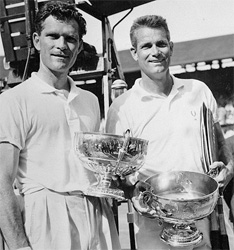
"Game, set, and match."
I cannot remember whether or not I actually heard the umpire say these words. There seemed to be a second of suspended time between the fact and the realization. Dimly I was aware of cheering crowds as I stood on the baseline, relaxed my limbs, flexed and unflexed my toes.
My glasses were steamed and blurred from my exertions in the blazing sun. I took them off and became conscious of my hot sticky hands. I put away my spectacles and rubbed my hands on my shorts.
Then it hit me. With Budge Patty I had at last won a title at Wimbledon and I was forty-three years old. That, I thought, would give them something to put in the record books.
The year was 1957.
The screaming and cheering of the crowds finally got through to me and I looked around at a white dazzle of waving hands, paper hats and handkerchiefs. Some spectators were even jumping up and down in the stands.
Seventeen thousand British people had apparently gone mad with joy over the triumph of an American. I felt a little ashamed; their tribute was more than I could have reasonably expected.
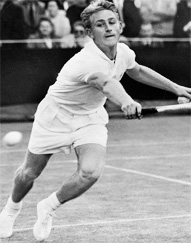
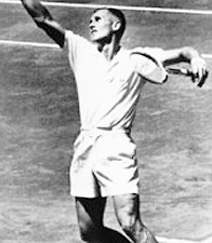
I walked over to Patty and we congratulated each other before shaking hands across the net with our opponents: Lew Hoad and Neale Fraser of Australia. This ritual of victory was not new to Patty--he had won the singles here in 1950 but the moment was none the less intoxicating for him.
Ask any tennis player from any corner of the globe who has played there, which is the greatest tennis tournament in the world and unhesitatingly will come the answer, 'Wimbledon!'
I have never a met a player who considered otherwise. Why? Because it is organized and run, if not solely for the player, then with the player as the first consideration.
Where else in the world is a grass court grown and tended with so much loving care for only two weeks use in the year?
Where else in the world are players treated with the same respect and recognition? Where else in the world is there an audience that loves so much and instinctively appreciates good tennis?
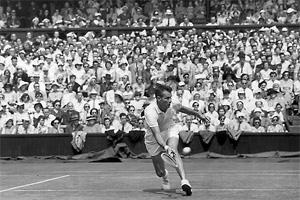
Nowhere is the answer to all those questions. I have a personal anecdote to tell which illustrates the uniqueness and greatness of Wimbledon. During the tournament the customary meal served to the players is salad. Despite the hot weather frequently prevailing, American players prefer a hot meal. One year I casually mentioned this to the Secretary of the All England Club, Colonel A. D. C. Macaulay. The following year there were hot meals for the players.
What is Wimbledon-besides the fabulous center court and the number one court? It is eighteen other grass courts, a bank, a post office, a telegraph office, a laundry, a restaurant, a wine cellar and printing presses.
In the ground stand a special booth selling postcard photographs of the competing players for sixpence each. Personal popularity with the audience can be judged by checking the sale of the photos. A different player's photograph appears on the cover of each day's newly printed program; and inside is a change of articles, stories and pictures along with up-to-date drawsheets of all events.
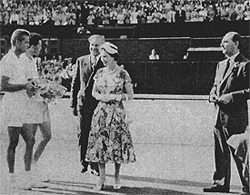
Throughout the ground permeates an atmosphere, an alchemy of thrilling expectation, tensed hope, and joyous anticipation, shared by both players and audience. In fact, at Wimbledon, the sympathy between player and audience is uncanny.
As we walked off the court the umpire clambered down off his stand and congratulated us. Then the Referee, Colonel John Legg came over and said: 'Boys, the Queen is coming down to make the presentation. Stand over here with me until she arrives.'
Carpets were laid on the court and within seconds Her Majesty Queen Elizabeth II of England was approaching us accompanied by Col. A. D. C. Macaulay, Secretary of the All England Club and Dr. Gregory, Chairman of the Wimbledon Committee.
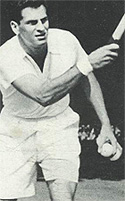
The tournament Referee, Colonel Legg, ushered us forward and we were presented. This was the moment of my life. For a tennis player the apex of achievement is a Wimbledon Championship; to win one and be presented with the trophy by the Queen is a twin event that would be almost impossible to surpass.
On handing me my doubles bowl she suddenly said: 'The last time I saw you, Mr. Mulloy, was at Lady Crossfield's garden party.' I could hardly hear her voice above the noise of the crowd. 'Yes, I remember,' I replied. 'But I could not have hoped that you would.'
I'll never forget it,' she replied with a smile. I knew only too well what she was smiling about.
In 1951 Dick Savitt and I had been invited to play an exhibition match at Lady Crossfield's. During the course of the day I was presented to Princess Elizabeth, as she was at the time. I asked her why she never came to Wimbledon, and helpfully offered to get her some tickets.
Lady Crossfield tactfully intervened and later explained that there was such a thing as the royal box. I felt seven kinds of a fool.
Back in the dressing room the tension began to drain out of me. This was my sixth Wimbledon doubles final but the strain of winning was a new experience. Normalcy returned with thoughts of home. I turned to Patty and said, "If only my Father had been here to see this."



